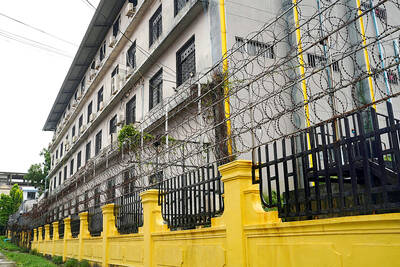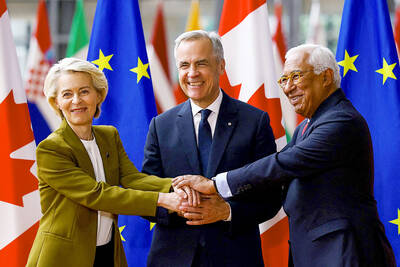Late strongman Juan Domingo Peron, who dominated Argentine politics like no other 20th-century leader with the glamorous Evita at his side, was to be buried yesterday for a third time since his death in 1974.
Peron's body was to be escorted by motorcade to a union hall for a midday tribute, then taken to a new US$1.1 million mausoleum in the cattle-ranching countryside, where supporters hope one day the embalmed body of his famous first lady might one day rest beside him.
Relatives of the late Eva Peron, or Evita, have opposed moving her remains from the tomb in Buenos Aires' downtown Recoleta cemetery, after a bizarre drama in which her remains made two transatlantic crossings since her death from cancer in 1952 at age 33.

PHOTO: AP
As Argentina's power couple, the Perons cultivated an enormous following with the working class by redirecting agricultural wealth to legions of urban poor through projects to build schools, hospitals and homes. Peron was elected president three times and died in office on July 1, 1974, at the age of 78.
President Nestor Kirchner and other members of the ruling Peronist party were expected to take part in yesterday's ceremonies. But the movement that bears Peron's name has suffered deep fissures over how best to advance his political legacy, and prominent intra-party rivals to Kirchner -- such as former presidents Carlos Menem and Eduardo Duhalde -- were expected to skip the proceedings.
Thirty-two years after Peron's death, supporters say he deserves a resting place befitting a national hero, instead of his current home in the crowded Chacarita cemetery -- where his hands were amputated and stolen by grave robbers in 1987.
Workers on Monday tore a hole in the side of Peron's crypt and removed the heavy metal coffin horizontally to avoid damaging his desiccated, formaldehyde-injected body, said Alejandro Rodriguez Peron, nephew of the late caudillo.
The remains were being transferred to a new coffin.
Peron was to be reburied at his former "Oct. 17" weekend estate in San Vicente, 45km southwest of Buenos Aires, in a marble sarcophagus set in a lofty, modern atrium. Outside a window, a towering eucalyptus tree will stand guard over his body.
The estate is named after the date in 1945 when Peron -- then-vice president and secretary of war -- was released after opponents in the military threw him in jail on accusations of conspiring against a previous government. Trade unionists and other supporters launched massive protests to help win his freedom after eight days, and Peron went on to win the first of three elections in February 1946.
An authoritarian leader who also had his enemies, Peron radically reshaped Argentina's economic and political life by nationalizing railroads, utilities and other industries to bankroll state programs for the poor and working classes.
The young, blond Evita became a national icon, and after her death her body lay in state in Congress for weeks as hundreds of thousands of mourners thronged to her coffin's open viewing.
When a group of military leaders overthrew Juan Peron in 1955, they were apparently so worried about a death cult that they secretly moved Evita's body to an unmarked grave in Italy. In 1971 it was delivered to Juan Peron's home in exile in Spain.
Peron returned to Argentina soon after and ruled briefly until his death. He was succeeded by his third wife, Isabel, who brought Evita's body to rest by his in the presidential residence in Buenos Aires. But after she too was ousted in a 1976 coup, the military quietly dispatched both bodies to their families' respective crypts.
Controversy continues to surround Juan Peron more than three decades after his death, as his remains were subjected on Friday to DNA sampling in a patrimony case.

Drug lord Jose Adolfo Macias Villamar, alias “Fito,” was Ecuador’s most-wanted fugitive before his arrest on Wednesday, more than a year after he escaped prison from where he commanded the country’s leading criminal gang. The former taxi driver turned crime boss became the prime target of law enforcement early last year after escaping from a prison in the southwestern port of Guayaquil. Ecuadoran President Daniel Noboa’s government released “wanted” posters with images of his face and offered US$1 million for information leading to his capture. In a country plagued by crime, members of Fito’s gang, Los Choneros, have responded with violence, using car

CYBERCRIME, TRAFFICKING: A ‘pattern of state failures’ allowed the billion-dollar industry to flourish, including failures to investigate human rights abuses, it said Human rights group Amnesty International yesterday accused Cambodia’s government of “deliberately ignoring” abuses by cybercrime gangs that have trafficked people from across the world, including children, into slavery at brutal scam compounds. The London-based group said in a report that it had identified 53 scam centers and dozens more suspected sites across the country, including in the Southeast Asian nation’s capital, Phnom Penh. The prison-like compounds were ringed by high fences with razor wire, guarded by armed men and staffed by trafficking victims forced to defraud people across the globe, with those inside subjected to punishments including shocks from electric batons, confinement

The team behind the long-awaited Vera Rubin Observatory in Chile yesterday published their first images, revealing breathtaking views of star-forming regions as well as distant galaxies. More than two decades in the making, the giant US-funded telescope sits perched at the summit of Cerro Pachon in central Chile, where dark skies and dry air provide ideal conditions for observing the cosmos. One of the debut images is a composite of 678 exposures taken over just seven hours, capturing the Trifid Nebula and the Lagoon Nebula — both several thousand light-years from Earth — glowing in vivid pinks against orange-red backdrops. The new image

Canada and the EU on Monday signed a defense and security pact as the transatlantic partners seek to better confront Russia, with worries over Washington’s reliability under US President Donald Trump. The deal was announced after a summit in Brussels between Canadian Prime Minister Mark Carney and European Commission President Ursula von der Leyen and European Council President Antonio Costa. “While NATO remains the cornerstone of our collective defense, this partnership will allow us to strengthen our preparedness ... to invest more and to invest smarter,” Costa told a news conference. “It opens new opportunities for companies on both sides of the